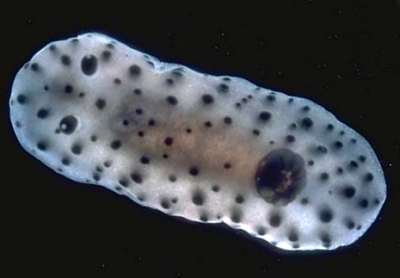
Hallaxa fuscescens
(Pease, 1871)
Order: NUDIBRANCHIA
Suborder: DORIDINA
Superfamily: EUDORIDOIDEA
Family: Actinocyclidae
DISTRIBUTION
Widespread Indo-West Pacific
PHOTO
PHOTOS: Upper right: Arrawarra Head, Coffs Harbour, nthn New South Wales, Australia. intertidal, on Halisarca. 16 March 1982. Live length 18 mm. AM C115783. Lower left: Another animal photographed on Halisarca at same time. Photos: BIll Rudman. A. Doris fuscescens Pease, 1871: Plate 4, fig.3, 3a-c. B. Kentrodoris nigra Risbec, 1928: Plate 2, fig.6
This species has a translucent body with low rounded black tubercles scattered over the mantle. The bipinnate gills are arranged in a tight, upright circle around the anal papillae. In Gosliner & Johnson's (1994) review of Hallaxa, a new species Hallaxa atrotuberculata is proposed for this species based on specimens from Madagascar and the Marshall Islands. I have also found this species in Tanzania, Australia and New Caledonia. There appear to be at least two earlier names for this species
Synonymy.
Doris fuscescens Pease, 1871b: 14, Pl.4, fig.3, 3a-c.
Kentrodoris nigra Risbec, 1928a: 91, Pl.2, fig.6., Risbec, 1953: 37.
Hallaxa nigra: Pruvot-Fol, 1930: 231.
Hallaxa atrotuberculata Gosliner & Johnson, 1994: 159-163, Figs 1A, 6, 7.
Pease (1871) described Doris fuscescens, from Maiao Is, Society Islands, which is identical in colour and has the typical gill arrangement of this group. The relationship is further confirmed by the description of the head region as `Mouth notched beneath; no distinct head or labial tentacles'. Risbec (1928) described Kentrodoris nigra from New Caledonia. The description is based entirely on the external features. The mantle is translucent gray with rounded black tubercles. The bipinnate gills form a tight circle, and the buccal tentacles are described as `lobiform', which are characteristic of Hallaxa. Pruvot-Fol (1930) in fact placed it in the genus Hallaxa.
This species clearly has a wide Indo-West Pacific distribution, and as I report in a separate message [#17533 ] it feeds on a species of halisarcid sponge. The appropriate name for this species would appear to be Hallaxa fuscescens.
- Pease, W.H. (1871) Descriptions of new species of Nudibranchiate Mollusca inhabiting Polynesia. No.2. American Journal of Conchology. 7 (1): 11-19
- Pruvot-Fol, A. (1930) Diagnose provisoires (incomplètes) des espèces nouvelles et liste provisoire des mollusques nudibranches recueillis par Mme. A. Pruvot-fol en nouvelle Calédonie (Ile des Pins). Bulletin du Museum National d'Histoire Naturelle Paris, 2: 229-232.
- Risbec, J. (1928) Contribution a l'étude des nudibranches Néo-Calédoniens. Faune des Colonies Francaises, 2(1): 328, pls.1-12.
- Gosliner, T.M. & Johnson, S. (1994) Review of the genus Hallaxa (Nudibranchia: Actinocyclidae) with descriptions of nine new species. The Veliger, 37(2): 155-191.
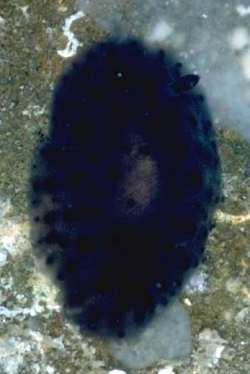
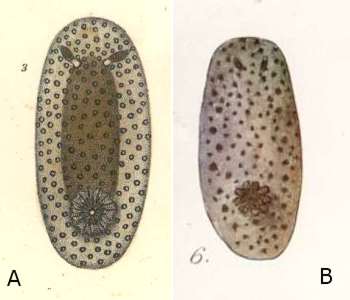
Rudman, W.B., 2006 (March 31) Hallaxa fuscescens (Pease, 1871). [In] Sea Slug Forum. Australian Museum, Sydney. Available from http://www.seaslugforum.net/find/hallfusc
Related messages
Hallaxa fuscescens from Mayotte Island
September 2, 2009
From: Matthias Deuss

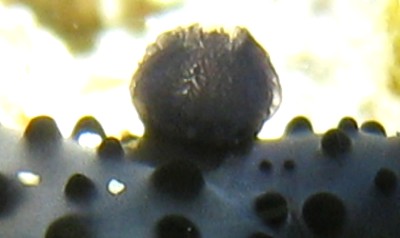
Dear Bill,
I found this little nudibranch moving among seagrass at low tide. It wasn't feeding. I have never seen it before, nor have I seen any picture of it, and it has not been recorded in Philibert Bidgrain's website.
Locality: Moutsoumbatsou reef, 1 metre, Mayotte Island, France, Mozambique Channel, Indian Ocean, 8 August 2009, Sand and seagrass. Length: 15 mm. Photographer: Matthias Deuss.
By the way, most of the nudibranchs I found on this reef, which is mostly covered by seagrass and seaweeds, were black or very dark, uncolored species : this one, Actinocyclus verrucosus and Dendrodoris nigra. Is it more than a coincidence ?
Thank you very much for your help,
Matthias Deuss
matthias976@hotmail.fr
Deuss, M., 2009 (Sep 2) Hallaxa fuscescens from Mayotte Island. [Message in] Sea Slug Forum. Australian Museum, Sydney. Available from http://www.seaslugforum.net/find/22622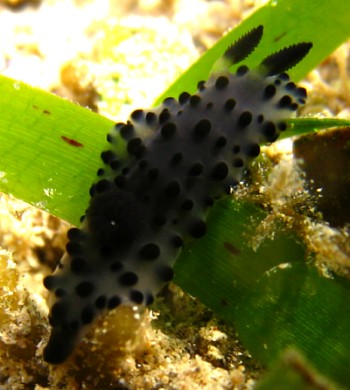
Dear Matthias,
This is Hallaxa fuscescens. In a recent message [#22626] I noted the characteristic shape of the gills in all species of Hallaxa. You can see the same goblet-shaped gill circlet in your animal as well.
Concerning finding three dull coloured species together. I am not sure if the colour similarity is significant, but these three dorids feed on sponges which can tolerate quite extreme ecological conditions. Certainly H. fuscescens can be found high on rocky shores and similarly Dendrodoris nigra can be found in luke-warm water in upper tidal pools. Shallow sea-grass beds are also not the best places for sponges but those that are found there are tough and adaptible. So I would say these three species were found together because of the adaptibilty of the sponges they feed on - but I don't know if their similar colouration is an adaptation for such conditions.
Best wishes,
Bill Rudman
Hallaxa fuscescens found sthn Queensland
November 25, 2008
From: Gary Cobb
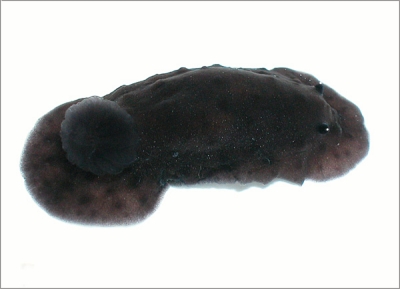
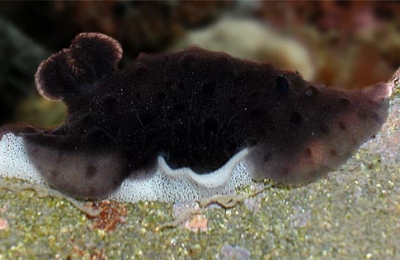
Concerning message #17550:
Hi Bill and everyone!
Here is a record of Hallaxa fuscescens found here in the intertidal zone at Alexandra Headland. We have found almost 100 species here. Also included is a photo of the animal spawning.
Locality: Alexandra Headland, Mooloolaba, 100 mm, Queensland, Australia, Pacific Ocean, 10 April 2004, Intertidal. Length: 20 mm. Photographer: Gary Cobb.
Cheers
Gary
gary@nudibranch.com.au
Cobb, G.C., 2008 (Nov 25) Hallaxa fuscescens found sthn Queensland. [Message in] Sea Slug Forum. Australian Museum, Sydney. Available from http://www.seaslugforum.net/find/22064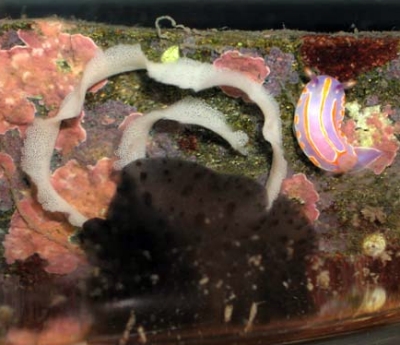
Thanks Gary,
It's nice to get a photo of its egg ribbon. In the middle photo we also get a good view of the 'goblet'-shaped gill cluster which is so characteristic of this family. I would be interested in any photos you have of it on its food sponge [see message #17533 ].
Also nice to see the photo of the very colourful form of Pectenodoris trilineata.
Best wishes,
Bill Rudman
Hallaxa fuscescens from the Philippines
July 10, 2007
From: Erwin Koehler

Concerning message #17550:
Dear Bill,
I have spent a long time looking for a name for this one, now i found at least a shot from the above message which looks very similar. Is it Hallaxa fuscescens?
Locality: Kalanggaman, Malapascua Island, 11m, Philippines, western Pacific Ocean, 13 March 2005. Length: 16mm. Photographer: Erwin Koehler.
Regards
Erwin
Erwin@Philippine-Sea-Slugs.com
Koehler, E., 2007 (Jul 10) Hallaxa fuscescens from the Philippines. [Message in] Sea Slug Forum. Australian Museum, Sydney. Available from http://www.seaslugforum.net/find/20061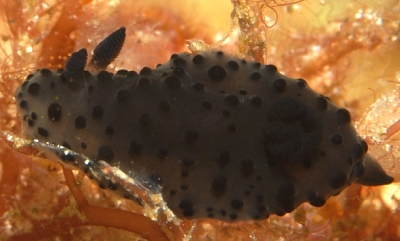
Dear Erwin,
Yes I would call this Hallaxa fuscescens.
Best wishes,
Bill Rudman
Hallaxa fuscescens from Heron Island, Queensland
August 23, 2006
From: Julie Marshall
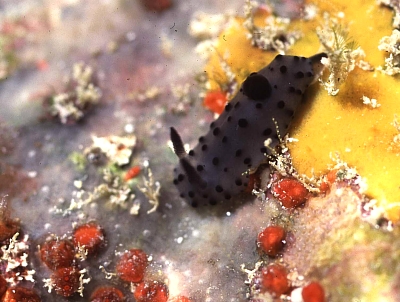
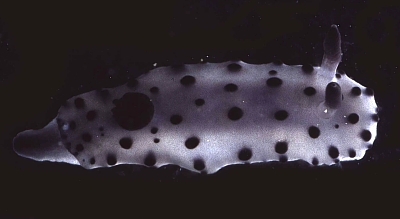
Dear Bill,
Following your images of Hallaxa fuscescens I am attaching a couple of photos of this species from Heron Island [Great Barrier Reef] It was found under a dead coral slab at the reef crest at low tide and was 16 mm in size.
Locality: Heron Island, Intertidal, Queensland, Australia, Pacific, 10 Nov. 2000, Intertidal. Length: 16 mm. Photographer: Julie Marshall.
Best wishes
Julie Marshall
juliemarshall@netspace.net.au
Marshall, J.G., 2006 (Aug 23) Hallaxa fuscescens from Heron Island, Queensland. [Message in] Sea Slug Forum. Australian Museum, Sydney. Available from http://www.seaslugforum.net/find/17550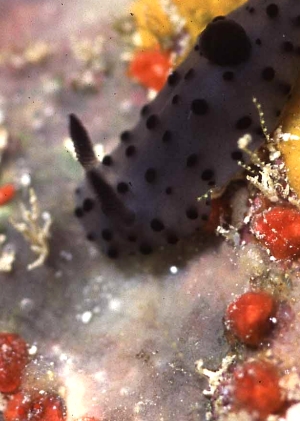
Dear Julie,
Thanks for this record. I don't know if you realised, but the translucent greyish 'film' that the Hallaxa has its head on in your photo, is a colony of the 'slime sponge' Halisarca on which I reported it feeding. In my photos, [message #17533], only patches of the sponge colony remain. Your message provides a valuable confirmation of my observations.
Best wishes,
Bill Rudman
Hallaxa fuscescens - feeding observations
August 21, 2006
From: Bill Rudman
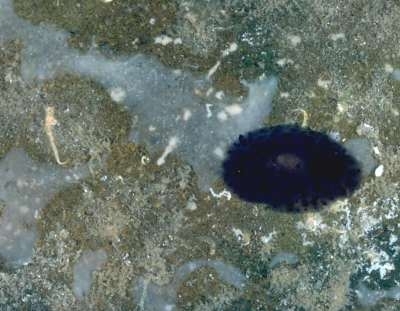
Hallaxa fuscescens is another species of Hallaxa which I have found feeding on a species of the 'slime sponge' Halisarca. The sponges are so named because they are often form a thin smooth slimy film over the rock on which they are attached. Often they are not noticed. In the upper photo, the sponge colony has been reduced to scattered fragments by the feeding activity of the 5 animals I found on it.
Locality: Arrawarra Head, Coffs Harbour, nthn New South Wales, Australia. Intertidal, 16 March 1982, live length of pictured animal, 18 mm. on Halisarca sp. AM. C115783
Bill Rudman
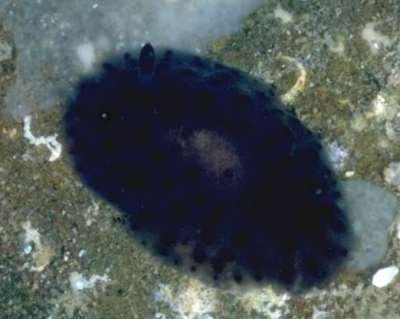
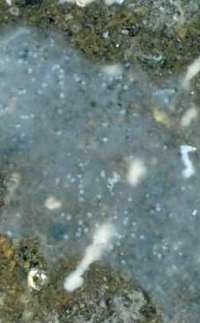
Rediscovery of Hallaxa fuscescens
August 21, 2006
From: Bill Rudman
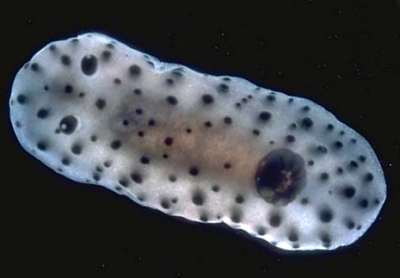
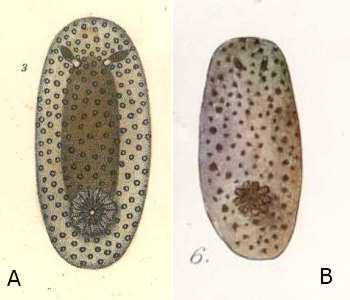
PHOTOS: Upper right: Arrawarra Head, Coffs Harbour, nthn New South Wales, Australia. intertidal, on Halisarca. 16 March 1982. Live length 18 mm. AM C115783. A. Doris fuscescens Pease, 1871: Plate 4, fig.3, 3a-c. B. Kentrodoris nigra Risbec, 1928: Plate 2, fig.6
In Gosliner & Johnson's (1994) review of Hallaxa, a new species Hallaxa atrotuberculata is proposed for a species from Madagascar and the Marshall Islands which is characterised externally by its rounded black tubercles. I have also found this species in Tanzania, Australia and New Caledonia. As I show here, there would appear to be at least two earlier names for this species
Synonymy.
Doris fuscescens Pease, 1871b: 14, Pl.4, fig.3, 3a-c.
Kentrodoris nigra Risbec, 1928a: 91, Pl.2, fig.6., Risbec, 1953: 37.
Hallaxa nigra: Pruvot-Fol, 1930: 231.
Hallaxa atrotuberculata Gosliner & Johnson, 1994: 159-163, Figs 1A, 6, 7.
Pease (1871) described Doris fuscescens, from Maiao Is, Society Islands, which is identical in colour and has the typical gill arrangement of this group. The relationship is further confirmed by the description of the head region as `Mouth notched beneath; no distinct head or labial tentacles'. Risbec (1928) described Kentrodoris nigra from New Caledonia. The description is based entirely on the external features. The mantle is translucent gray with rounded black tubercles. The bipinnate gills form a tight circle, and the buccal tentacles are described as `lobiform', which are characteristic of Hallaxa. Pruvot-Fol (1930) in fact placed it in the genus Hallaxa.
This species clearly has a wide Indo-West Pacific distribution, and as I report in a separate message [#17533 ] it feeds on a species of halisarcid sponge. The appropriate name for this species would appear to be Hallaxa fuscescens.
- Pease, W.H. (1871) Descriptions of new species of Nudibranchiate Mollusca inhabiting Polynesia. No.2. American Journal of Conchology. 7 (1): 11-19
- Pruvot-Fol, A. (1930) Diagnose provisoires (incomplètes) des espèces nouvelles et liste provisoire des mollusques nudibranches recueillis par Mme. A. Pruvot-fol en nouvelle Calédonie (Ile des Pins). Bulletin du Museum National d'Histoire Naturelle Paris, 2: 229-232.
- Risbec, J. (1928) Contribution a l'étude des nudibranches Néo-Calédoniens. Faune des Colonies Francaises, 2(1): 328, pls.1-12.
- Gosliner, T.M. & Johnson, S. (1994) Review of the genus Hallaxa (Nudibranchia: Actinocyclidae) with descriptions of nine new species. The Veliger, 37(2): 155-191.
